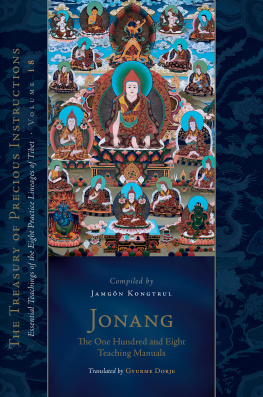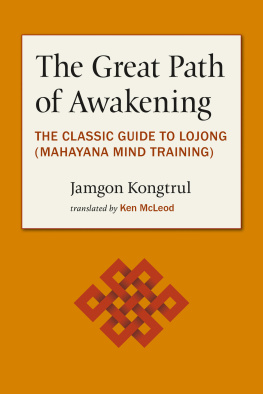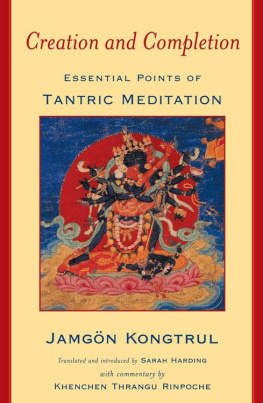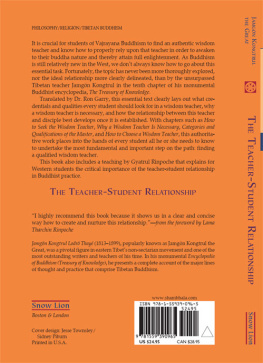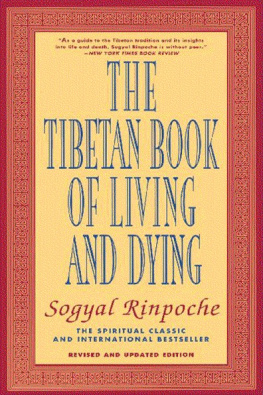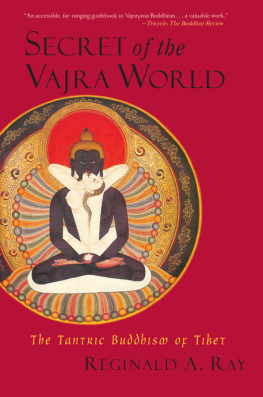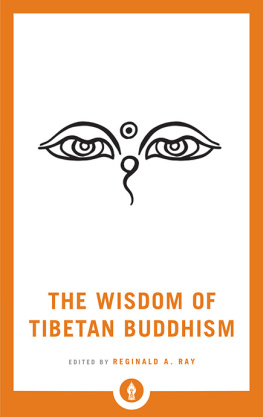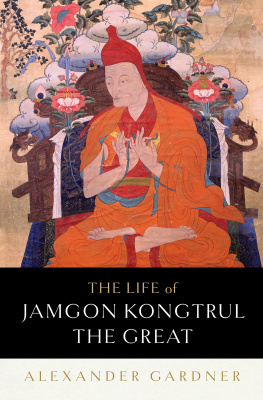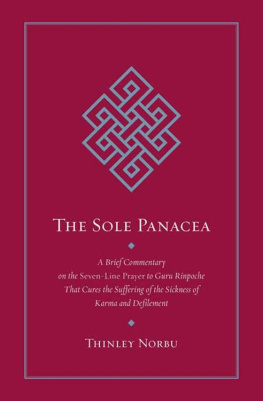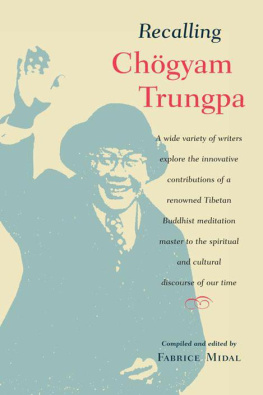ABOUT THE BOOK
This translation of a fundamental Tantric text reveals the richness and profundity of the intellectual and contemplative traditions of Tibetan Buddhism. The text describes the Four Foundation Practices that all practitioners of Vajrayana Buddhism must complete. The nature of impermanence, the effects of karma, the development of an enlightened attitude, and devotion to the guru are among the subjects treated in this book.
Three eminent contemporary Tibetan Buddhist mastersKalu Rinpoche, Deshung Rinpoche, and Chgyam Trungpa Rinpocheexplain the significance of The Torch of Certainty for modern-day students and practitioners of Tibetan Buddhism.
JAMGON KONGTRUL (18131899) was a versatile and prolific scholar. He has been characterized as a Tibetan Leonardo because of his significant contributions to religion, education, medicine, and politics.
Sign up to receive weekly Tibetan Dharma teachings and special offers from Shambhala Publications.

Or visit us online to sign up at shambhala.com/edharmaquotes.
The Torch of Certainty
Jamgon Kongtrul the Great
Translated from the Tibetan by Judith Hanson
Foreword by Chgyam Trungpa

Shambhala
Boulder 2016
SHAMBHALA PUBLICATIONS, INC.
4720 Walnut Street
Boulder, Colorado 80301
www.shambhala.com
1977 Judith Hanson & Shambhala Publications, Inc.
All rights reserved. No part of this book may be reproduced in any form or by any means, electronic or mechanical, including photocopying, recording, or by any information storage and retrieval system, without permission in writing from the publisher.
LIBRARY OF CONGRESS CATALOGING-IN-PUBLICATION DATA
Ko-sprul Blo-gros-mtha-yas, 1813-1899.
The torch of certainty.
Translation of es don sgron me
Reprint. Originally published: Boulder, Colo.: Shambhala, 1977.
Bibliography: p.
Includes index.
1. Meditation (Tantric Buddhism.) 2. Kar-ma-pa (Sect.)LiturgyTexts. I. Hanson, Judith. II. Title.
BQ7805.K6613 1983 294.3443 82-24522
eISBN 978-0-8348-2982-4
ISBN 1-57062-713-4 (pbk.)
BVG 01
TO KALU RINPOCHE, beloved Lama
who has urged that practice of the Four Special Foundations be preceded by ritual authorization to use the texts (lung), one Vajrayana empowerment (wong), and a Lamas instructions (tri). These will inform your practice and contribute to its success.
This book contains diacritics and special characters. If you encounter difficulty displaying these characters, please set your e-reader device to publisher defaults (if available) or to an alternate font.
The spirituality of Buddhism is a nontheistic one. It deals with the ways and means of attaining enlightenment, discovering Buddha within through the aid of great teachers and the diligent practice of meditation. It has always been emphasized that one does not purely practice the Dharma, but one becomes the Dharma.
The teachings of Buddha are divided into three sections: Hinayana, Mahayana, and Vajrayana. They should be methodically practiced in this order. If one does not begin at the beginning, there is a danger of provoking further confusion, of viewing practice as entertainment, which only causes greater arrogance and neurosis.
The pattern of the practitioners progress through the three yanas is as follows: First, one develops extreme exertion in uncovering ones own neurosis. This one-pointed mindfulness brings the sense of ones actual human quality. The second stage is marked by gentleness, allowing ones energies to expand and be shared with the rest of sentient beings. Finally, one develops fearlessness and a sense of joy and penetrating insight, filled with immense devotion to the lineage and ones root-guru. This text, dealing with the preliminary practices of the Vajrayana discipline, belongs to the third category.
I am very pleased that this authentic torch of certainty is available to those who are inspired to follow the Vajrayana path. It was written by Jamgon Kongtrul the Great, whose reincarnation, Jamgon Kongtrul of Zhe-chen, was my root-guru. Those who are deeply inspired by this book should receive oral transmission from a living lineage-holder. They should have a strong foundation in Hinayana and Mahayana as a prelude to entering the path of Vajrayana. This is the way which has been taught.
Judith Hanson has put a great deal of energy and devotion into the translation of this text. The fruition of her effort is evidence of her karmic link with the Kagyud tradition.
Vajracarya the Venerable Chgyam Trungpa
March 1, 1977
Jamgon Kongtruls The Torch of Certainty (Nges-don sgron-me) is a text of great importance to students of Buddhism because it deals with a set of basic meditative practices in current use by all Tibetan sects. These are the Four Foundations or preliminary practices (sngon-gro).
This annotated translation of Nges-don sgron-me is preceded by two introductory chapters. The first contains some historical background on the text, the author and his sect, the Karma Kagyudpa. The second contains a description of the general procedures for practice of the Four Foundations, as well as transcripts of interviews with three leading Lamas (Venerable Kalu Rinpoche, Venerable Deshung Rinpoche and Venerable Chgyam Trungpa, Rinpoche), who answer the questions of a prospective practitioner.
Each chapter of the translation is preceded by further introductory remarks. The introductions to chapters 2 through 5 contain detailed instructions for practice. These were given by Kalu Rinpoche and his representative Lama Tsengyur Rinpoche (Tsewong Gyurme) at Kagyu Kunkhyab Chuling in Vancouver.
Throughout the text non-English terms in parentheses are transliterations of the Tibetan, unless otherwise noted.
Frequently cited in the notes are the comments of four authoritative Tibetan informants: Kalu Rinpoche, Tsengyur Rinpoche, Deshung Rinpoche and Lobsang P. Lhalungpa. Through their responses to my questions at numerous interviews, these men provided traditional oral commentary which made the text intelligible to me and made its translation possible. A biographical sketch of each of these Tibetans will shed light on their contributions.
The Venerable Kalu Rinpoche, one of several contemporary incarnations of Jamgon Kongtrul, is a meditation master of both the Shangpa and Karma branches of the Kagyud sect. He is one of the few refugee Lamas fully trained in Tibet. Born in Kham (eastern Tibet) in 1904, he was educated by his father until the age of sixteen. Thereafter, his principal teacher was Lama Norbu Dondrub, a pupil of Jamgon Kongtrul. At twenty-five, Rinpoche began twelve years of intensive meditation in an isolated retreat. Subsequently, he was in charge of the meditation center at Kongtruls former monastery of Palpung for fifteen years. There he guided monks in the Four Foundations and more advanced practices such as the Six Yogas of Naropa. In the late 1950s he fled to Bhutan and established a monastery. Five years later he moved to northern India and founded Samdub Tarjay (bSam-grub Thar-byed) monastery at Sonada, where he now supervises more than thirty monks in meditation.
While touring Europe and North America in 1972 and 1974-5, Rinpoche established approximately thirty Buddhist centers. During his visit to Vancouver, he left his disciple Lama Tsewong Gyurme as meditation teacher and spiritual guide of the newly founded Kagyu Kunkhyab Chuling.
Lama Tsewong Gyurme (abbreviated Lama or the Lama in the following chapters) was born in Kham in 1939. He received his primary education at a Karma Kagyud monastery, but at sixteen went to Zhechen, the Nyingma monastery where Jamgon Kongtrul received his original monastic vows. There he was ordained and studied the philosophical works of the renowned Nyingma scholar Lama Mipham (1846-1912). At nineteen he fled to Bhutan where he lived and worked at Kalu Rinpoches monastery for five years. He followed Rinpoche to India in 1963. With the founding of Samdub Tarjay monastery in Sonada, Tsewong Gyurme was able to pursue his lifelong ambition of intensive meditative practice. Soon after his completion of the traditional three year meditation retreat, at Kalu Rinpoches request he came to Canada. Since 1972 he has been instructing students at Kagyu Kunkhyab Chuling in the fundamental tenets of Buddhism, the meditation on Avalokiteshvara (sPyan-ras-gzigs), the Four Foundations and other basic practices.
Next page

